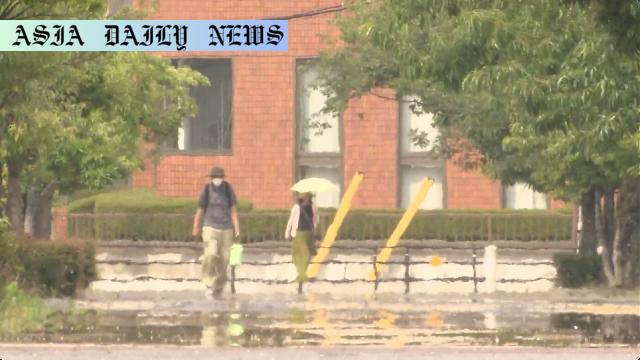Heatwave: Scorching temperatures persist across Japan. Widespread heatstroke alerts issued as mercury rises to 38°C.

Scorching Heatwave Hits Japan
Japan is currently battling a significant heatwave, with temperatures reaching dangerously high levels across multiple regions. Thursday’s forecast indicates that the southwestern region of Kyushu will be one of the hardest-hit areas, with a maximum temperature of 38°C expected in Oita Prefecture’s Hita City and Fukuoka Prefecture’s Kurume City. Western Japan cities such as Yamaguchi, Okayama, and Maebashi are also preparing for temperatures ranging from 36°C to 37°C.
In addition to western areas, the country as a whole is experiencing extreme weather. The Meteorological Agency highlights central locations such as Kyoto, Osaka, and Tokyo with temperatures ranging from 33°C to 35°C. This relentless heat has prompted wide-scale heatstroke alerts, urging residents to stay hydrated, rest frequently, and make use of air conditioning to stay cool.
Government and Meteorological Agency Warnings
The Meteorological Agency has issued heatstroke alerts for Hyogo Prefecture, parts of the Chugoku region excluding Okayama Prefecture, the Shikoku region, Kyushu region excluding Kagoshima’s Amami region, and Okinawa’s Yaeyama region. Such alerts emphasize the critical need for precautionary measures this week, particularly for outdoor activities during peak daytime hours. Public health officials strongly advise individuals to drink plenty of water, eat salty foods if appropriate, and limit their time under direct sunlight.
However, the extreme heat isn’t the only concern. The agency points out that atmospheric instability might lead to sudden localized downpours, accompanied by thunder and lightning in regions such as Kinki and Tokai. Authorities are also urging people to prepare for potential secondary impacts, including landslides, swollen rivers, and gusty winds.
Impact of the Heatwave on Daily Life
As temperatures persist at record-breaking highs, residents are already feeling the brunt of what could be one of Japan’s most challenging summer seasons in recent history. Outdoor workers, children, and the elderly remain vulnerable to heat-related illnesses, including severe dehydration and heatstroke. Consequently, schools and workplaces are modifying schedules to minimize exposure to soaring temperatures.
Local governments have also established cooling centers in urban and rural areas to assist those who may lack access to air conditioning. Despite such measures, hospitals are reporting a steady increase in heat-related illnesses, underscoring the critical nature of adhering to guidelines and staying vigilant during this heatwave.
Preparing for Thunderstorms and Secondary Hazards
While the heat dominates current conversations, meteorological experts warn of possible thunderstorms as a result of unstable atmospheric conditions. Areas such as western to northern Japan are particularly susceptible to such weather fluctuations. These thunderstorms bring an associated risk of flash flooding, lightning strikes, gusty winds, and hail, further complicating the heatwave response efforts.
Weather authorities are advising residents to monitor updates throughout the day to ensure they are prepared for such sudden events. Travelers and commuters should also exercise caution, as heavy rainfall in some areas might lead to traffic disruptions and delays in public transit systems.
Conclusion and Long-Term Considerations
The severe heatwave sweeping through Japan will likely exacerbate once-in-a-century climate challenges the nation has been facing. From adjusting daily routines to addressing widespread heatstroke cases, this period serves as a sharp reminder of the importance of climate preparedness. Going forward, nationwide measures will likely need to include enhanced infrastructure, sustainable cooling solutions, and better public awareness campaigns to mitigate the impact of such extreme weather.
Commentary
Understanding the Human Impact of Japan’s Heatwave
This ongoing heatwave in Japan is a sobering reminder of the immediate effects of climate change and the vulnerabilities experienced by urban and rural populations alike. It’s awe-inspiring yet disheartening to think how something as elemental as temperature can influence and disrupt daily life for millions of people. The sweltering heat, as reported, poses a particular concern for vulnerable communities, such as the elderly and outdoor workers, who may struggle to adapt to rapidly rising temperatures. Their plight underscores the need for comprehensive, societal-level actions to mitigate health risks during such extreme events.
Challenges in Managing Preparedness
The issuing of heatstroke alerts and public advisories highlights an essential aspect of government intervention. However, this isn’t merely about distributing information or fortifying warnings. It is about fostering resilience—both in infrastructure and mindset. Cooling centers, for instance, are critical lifelines for those without access to air conditioning. Still, the depth and reach of such measures are often constrained by funding, logistics, and accessibility, particularly in rural areas. Perhaps this underscores the importance of community initiatives and collaborative solutions where public resources may fall short.
A Broader Reflection
Extreme weather events, like this heatwave, are increasingly becoming a central fixture in discussions about global warming and climate preparedness. As Japan experiences temperatures inching towards 40°C, countries worldwide are observing these moments in real-time, understanding that their own regions may encounter similar extremes sooner rather than later. Cases like this implore us to rethink societal adaptations—not just in response to weather events but in proactively redesigning cities, reassessing energy use, and creating lifestyles that are inherently more resilient to environmental changes.
Final Thoughts
Ultimately, Japan’s efforts to combat the intense heatwave offer valuable lessons for other nations grappling with the risks of a warming planet. It reinforces that individual, community, and governmental actions must align to reduce harm during these catastrophes. In doing so, societies globally can better weather the storms—or heat—on the horizon.


